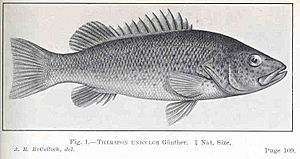Spangled grunter facts for kids
Quick facts for kids Spangled grunter |
|
|---|---|
 |
|
| Conservation status | |
| Scientific classification | |
| Synonyms | |
|
The spangled grunter or spangled perch (scientific name: Leiopotherapon unicolor) is a cool type of fish. It's known as a grunter because of the sounds it can make! This fish belongs to the Terapontidae family. You can only find it in Australia, which means it's an endemic species there.
Contents
What Does a Spangled Grunter Look Like?
The spangled grunter has a slim, oval-shaped body. It looks a bit flattened from side to side. Young grunters are more rounded. Their snout is long, and their mouth points upwards.
They have strong, cone-shaped teeth. The teeth on the outside are bigger. There are no teeth on the roof of their mouth.
This fish has one long dorsal fin on its back. The front part of this fin has 11 to 13 sharp spines. The back part has 9 to 12 soft rays. The anal fin on its belly has 3 short spines and 7 to 10 soft rays. Its tail fin is slightly notched.
Spangled grunters are very pretty fish. Their bodies are silvery-grey or silvery-blue. They have many reddish-brown spots all over, except on their belly. Young fish have a clear dark bar on the lower part of their tail fin. The biggest spangled grunter ever recorded was about 31 centimeters long.
Where Do Spangled Grunters Live?
The spangled grunter lives in more places than any other freshwater grunter in Australia. You can find them across most of the northern two-thirds of the continent. Their range extends as far south as Newcastle, New South Wales.
Spangled Grunter Habitat and Life
Spangled grunters are super tough fish! They can live in many different water conditions. This includes fast-flowing rivers or still ponds. They don't mind if the water is clear or very muddy. They can also handle a wide range of saltiness and temperatures.
You'll often find them in temporary water bodies. These are places that might dry up sometimes. They also live in lakes, dams, rivers, and waterholes. In the middle of Australia, you might even find them in puddles in wheel ruts after it rains!
Sometimes, people think these fish fall from the sky during "rain of fish" events. But really, they are just carried to new places by floods. This hardy fish can survive dry times by burying itself in the mud. It stays there until the water returns. This is called aestivation.
What Do Spangled Grunters Eat?
Spangled grunters are omnivores. This means they eat both plants and animals. Their diet mostly includes insects that live in or near water. They also eat crustaceans like tiny shrimp. Sometimes, they eat molluscs like snails. They will even eat small fish. A small amount of their diet also comes from algae and water plants.
Reproduction and Life Cycle
Spangled grunters start to spawn (lay eggs) in November. This happens when the water temperature reaches about 20 to 26 degrees Celsius. They usually spawn at night.
Before laying eggs, the fish move upstream in rivers. In lakes, they move to shallow areas. They lay their eggs on soft beds. The eggs hatch in about two days. The baby fish, called larvae, take about 24 days to become juveniles. The male grunter guards the eggs and fans them with his fins.
Female grunters can start laying eggs when they are about 78 millimeters long. A female weighing 24 grams can produce about 24,000 eggs! A larger female, around 65 grams, can lay an amazing 113,200 eggs.
How Was This Fish Discovered?
The spangled grunter was first officially described in 1859. It was named Therapon unicolor back then. The person who described it was Albert Günther. He was a German-born British fish expert and reptile and amphibian expert. He lived from 1830 to 1914. The first fish he studied came from Mosquito Creek and the Gwydir River in New South Wales, Australia.


